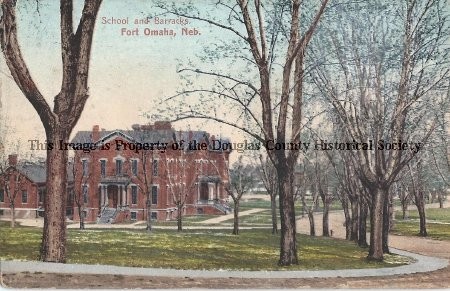Fort Omaha
Introduction
Text-to-speech Audio
Fort Omaha, originally known as the Sherman Barracks and later as the Omaha Barracks, opened in 1868. Now a part of the Metropolitan Community College campus, Fort Omaha was at the canter of the city's history. The fort operated as the home base of the Department of the Platte and was also the site of the trial of Standing Bear, chief of the Ponca tribe. Fort Omaha was also the home of one of the nation's first military balloon schools, a supply depot, a muster point for troops, and one of the many Nebraska prisoner-of-war camps housing captured Italian soldiers during the Second World War.
Images
Fort Omaha School and Baracks (1912)

Fort Omaha Ballon School

Arial Shot of Fort Omaha (1917)

Backstory and Context
Text-to-speech Audio
What is now known as Fort Omaha was first established in 1868 as the Sherman Barracks by then-Captain (and eventually Brigadier General) William Sinclair of the United States Army's 3rd Artillery unit. The land on which the Fort was built was purchased by the federal government from Augustus Kountze, a businessman well-known in the area. Following the National Banking Act of 1863, Kountze and his brothers founded the First National Bank of Omaha. Kountze also assisted in the establishment of the Union Pacific Railroad and served on the original Board of Directors for Union Pacific, and served as Treasurer of the Nebraska Territory and the State of Nebraska.
The Fort was officially renamed Fort Omaha on December 30, 1878, and was designated as the headquarters of the newly created Department of the Platte within the United States Army. Its jurisdiction stretched across both Nebraska and Iowa, as well as the Dakota and Utah Territories and a small piece of Idaho. The Department provided services meant to sustain and encourage emigration throughout the American West; such services included protecting mail routes and telegraph lines, building routes and bridges (including the later construction of Union Pacific Railroad).
This was also the site of the 1879 trial of Standing Bear v. Crook. Standing Bear was the chief of the Ponca, a tribe of Native Americans who had been relocated to the Quapaw Reservation in Oklahoma. The reservation's conditions were deplorable with bad sanitation, famine, and a malaria outbreak among the most notable issues. Ultimately, roughly one-third of the Ponca died, including Standing Bear's son Bear Shield. IConditions led Standing Bear and his followers to leave the reservation without permission from the federal government, as he had promised to bury his son in the Omaha Reservation.
General George Crook ordered Standing Bear and his followers to be arrested and detained at Fort Omaha. Due to their weak physical condition, General Crook, who was sympathetic to the Native American perspective, allowed the Ponca to rest and rehabilitate themselves at Fort Omaha. During this time, General Crook alerted Thomas Tibbles, an editor at the Omaha Daily Herald (precursor to the Omaha World-Herald), to the Ponca's story. Tibbles brought public attention to the affair. Standing Bear and his lawyers then sued for a writ of habeas corpus. The case concluded with Judge Elmer S. Dundy stating that Native Americans should be allowed the same rights and protections. This was a landmark case not only as it related to racial tensions in Omaha but also within the realm of civil rights as a whole.
During the Spanish-American War, Fort Omaha became a muster point for troops. During World War I, the Fort operated as the first military balloon school in the United States. Several balloon companies were stationed at the Fort, and the Army experimented with a large, sunfish-shaped dirigible from Italy. During World War II, Fort Omaha became one of several prisoner-of-war camps across Nebraska, interning approximately 12,000 captured Italian soldiers. Those imprisoned were also used to supplement the depleted civilian workforce of the state.
Sources
“Aeronautical Notes.” Scientific American 97, no. 13 (1907): 223. Clark, Stanley. "Ponca Publicity." The Mississippi Valley Historical Review 29, no. 4 (1943): 496.
Baker, R. A. "Sunfish Ballon is Said to be a Wonder." Fort Omaha Gas Bag, October 25, 1918. http://www.douglascohistory.org/wp-content/uploads/2015/11/Fort-Omaha-Gas-Bag-Oct-25-1918.pdf.
Carlson, Janet. “Nebraska Roots Nurture Philanthropy.” UNL College of Journalism and Mass Communications Archive. Accessed December 10, 2019. https://unlcms.unl.edu/journalism2/cojmc/alumni/jnews/archive/9900_winter/foundation.html.
Guentzel, Richard. “The Department of the Platte and Western Settlement, 1866-1877.” Nebraska History 56 (1975): 388-417.
“POWs Far from the Battleground.” Nebraska Studies. Accessed December 8, 2019. http://www.nebraskastudies.org/1925-1949/pows-far-from-the-battleground/.
Radzievich, Nicole. “Veteran Tells Forgotten Story of WWII POW Camps in the U.S.” Morning Call (Allentown, PA), Nov. 10, 2016.
Starita, Joe. "The Case of Standing Bear: Establishing Personhood under the Law." Court Review: The Journal of the American Judges Association 45, no. 1-2 (2009).
“Trail Map.” Chief Standing Bear: The Trail Ahead. Accessed December 7, 2019. http://chiefstandingbear.org/trail-map/.
“Trial of Standing Bear.” Nebraska Studies. Accessed October 15, 2019. http://nebraskastudies.org/1875-1899/the-trial-of-standing-bear/.
“William Sinclair, Brigadier General, United States Army.” Arlington Cemetery. Accessed December 11, 2019. http://www.arlingtoncemetery.net/william-sinclair.htm.
https://douglascountyne.pastperfectonline.com/photo/84160550-A060-4B1F-ADAA-905302761952
https://douglascountyne.pastperfectonline.com/photo/8980040F-38C7-4A63-B90C-595586858177
https://douglascountyne.pastperfectonline.com/photo/84160550-A060-4B1F-ADAA-905302761952
